
On the night of Jul 15/16, 2014, I observed the cataclysmic variable star ASAS-SN14cv. You can read more about this star, which was discovered only recently, at
ASAS14cv shows some variation, and has faded to V = 13.6 or so.
I also checked a SN candidate in the galaxy UGC 9267, after seeing it mentioned on
I confirmed that the candidate was present, but couldn't say much more.
The main setup was:
Notes from the night
Below is a graph showing the sky brightness as a function of time during the observing run. Note the clouds passing through near the start.

Below is a graph showing the FWHM as a function of time during the observing run.

Here's a chart of the field of ASAS-SN14cv, which is at
RA = 17:43:48.58 Dec = +52:03:46.8 (J2000)
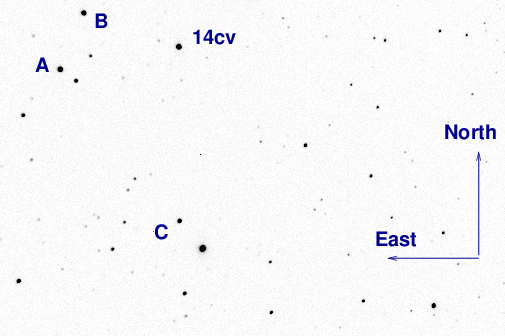
Some of the reference stars marked above have magnitudes in the UCAC4. Specifically, star "A" above is
The television camera on the finder scope shows the following when we're pointed at ASAS-14cv. North up, East left, field about 1 degree on a side.
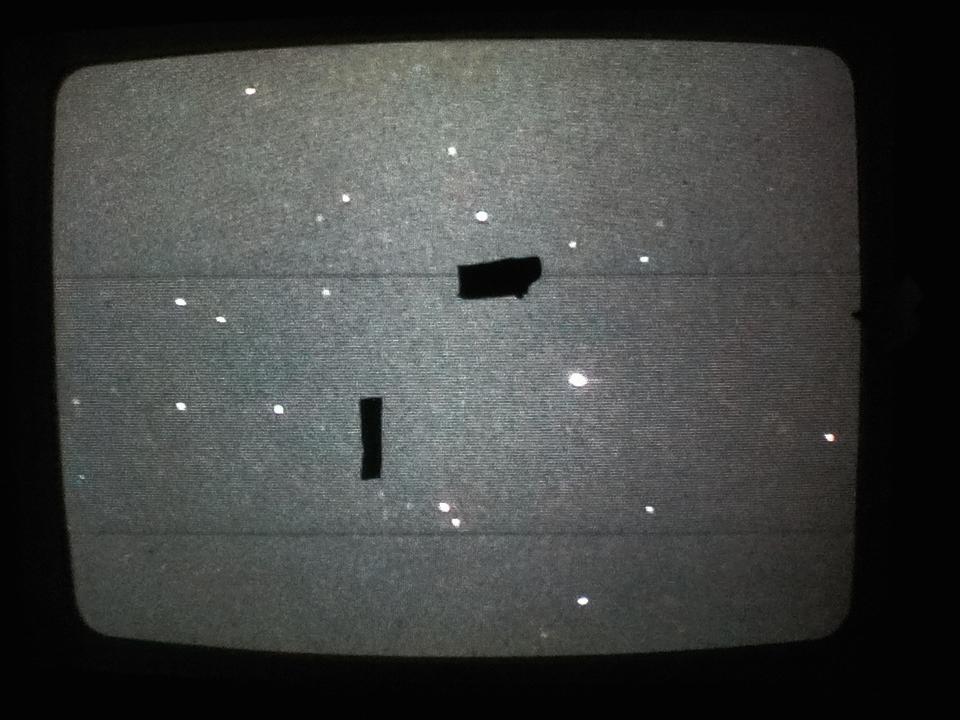
The image adjustment factor graph shows that clouds passed very briefly.
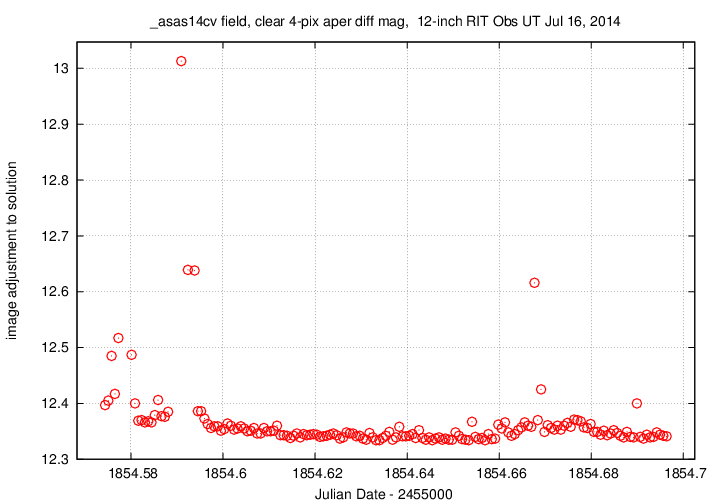
Using aperture photometry with a radius of 4 pixels (radius of 7.4 arcsec), I measured the instrumental magnitudes of a number of reference stars and the target. Following the procedures outlined by Kent Honeycutt's article on inhomogeneous ensemble photometry, I used all stars available in each image to define a reference frame, and measured each star against this frame. I used the UCAC4 V-band magnitude of star "A" to convert the ensemble instrumental magnitudes to a reported "V"-band magnitude (but remember, it's a clear filter).
Sigma-vs-mag plot:
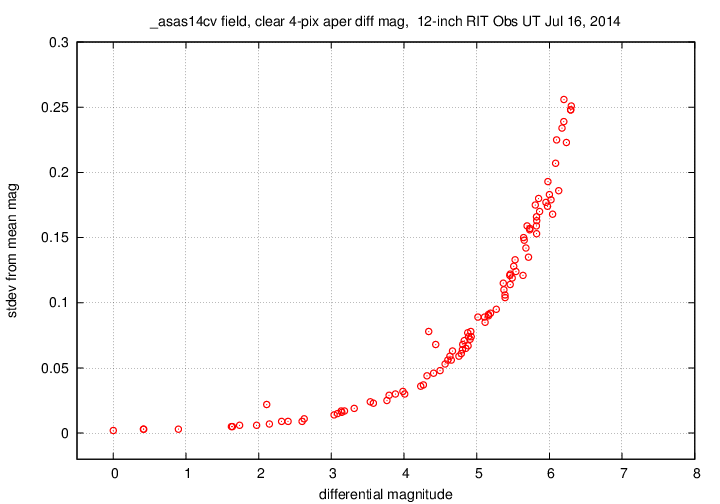
The target shows the gentle low-amplitude variation it has had for several days.
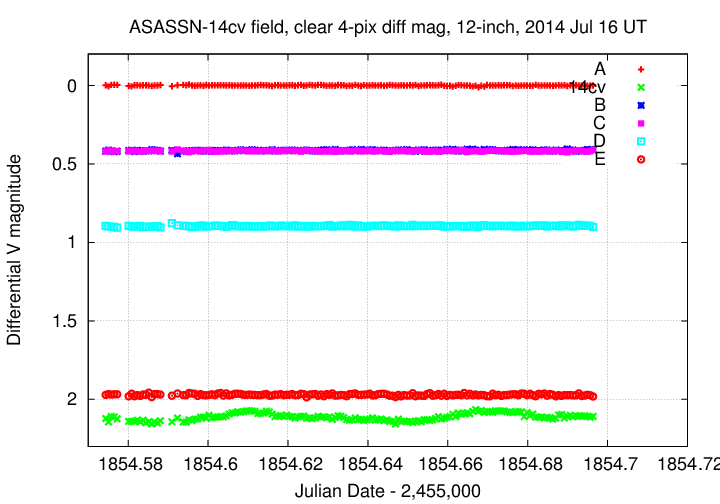
You can see my measurements of the star in the ASCII text file below. The first few lines are shown here:
# Measurements of ASAS_SN14cv made at RIT Obs, Jul 16, 2014 UT, # in fair conditions. # by Michael Richmond, using 12-inch Meade and SBIG ST-8E CCD. # Exposures 45 seconds long, no filter. # Tabulated times are midexposure (FITS header time - half exposure length) # and accurate only to +/- 1 second (??). # 'mag' is a differential magnitude based on ensemble photometry # using a circular aperture of radius 7.4 arcseconds. # which has been shifted so UCAC4 711-058151 has mag=11.518 # which is its V-band mag according to UCAC4. # # UT_day JD HJD mag uncert Jul16.07437 2456854.57437 2456854.57561 13.640 0.007 Jul16.07507 2456854.57507 2456854.57631 13.662 0.007 Jul16.07579 2456854.57579 2456854.57703 13.627 0.007
The CBAT Transients Confirmation Page showed a report during the night of a SN candidate in UGC 9267:
2014 07 15.8600 Mario Bombardini and Mirco Villi (Urania Lamonia Observatory-Faenza-Italy) report the discovery of a possible supernova in UGC 9267 with a 0,35 mt. Sch.-Cass. f/5.0 + Sbig ST9 CCD camera on several unfiltered images taken on July 15,86 UT, 60 sec. exp., at mag. 16,0, limit mag. 19,0. The new object is located at RA 14h27m49s, DECL +11:33:40 (J2000.0) which is 15'' W and 7'' N from the galaxy's centre. Previous images of the galaxy taken on May 20, 2014 show nothing at that position, also in POSS II red and blue plates. No know minor planets are in that area during discovery time.
At the end of my run, UGC 9267 was pretty low in the western sky -- near airmass 3 -- but I took a set of 5 unfiltered images, each 45 seconds long. When I coadded them, I saw this:
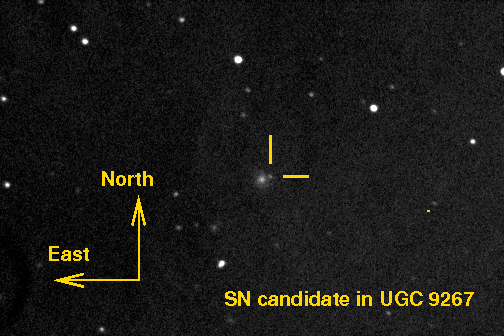
There is indeed a faint point source, roughly V = 16 (using nearby stars, UCAC4 magnitudes, and the eyeball) in the right place: to the galaxy's north-west.
I sent an E-mail message to the CBAT.
Michael Richmond (Rochester Institute of Technology) reports that observations at UT July 16 01:48 = July 16.075 with a 12-inch f/10 Schmidt-Cassegrain telescope + unfiltered SBIG ST-8E CCD camera at the RIT Observatory confirm the SN candidate PSN J14274900+1133400. The object is at offset approx (6 arcsec N, 15 arcsec W) and has magnitude approx V = 16.
Last modified 7/14/2014 by MWR.